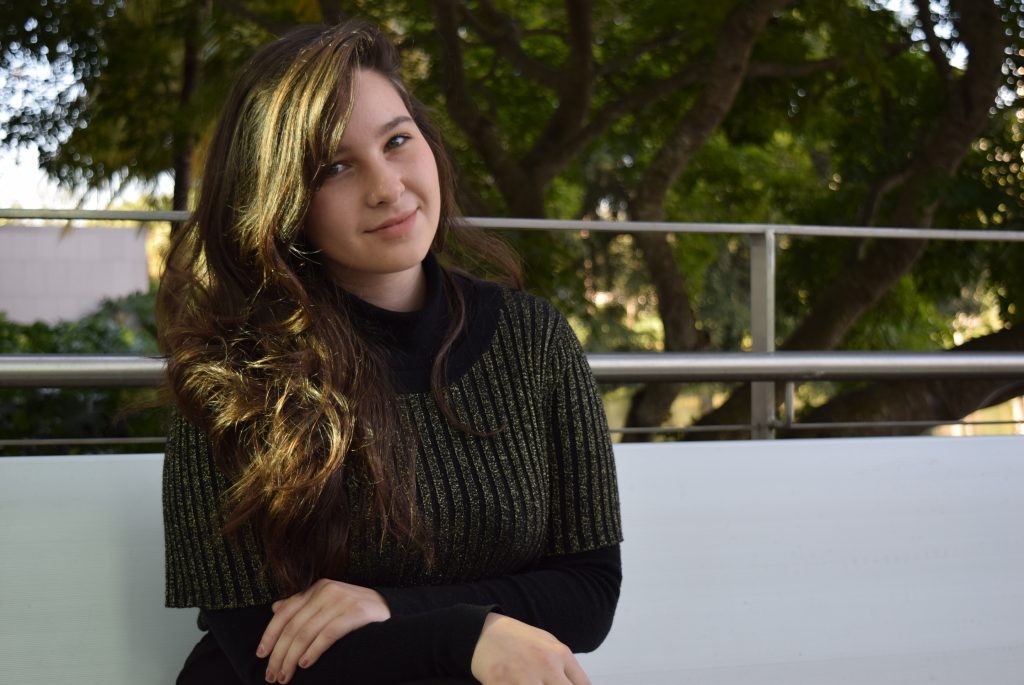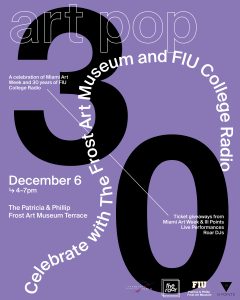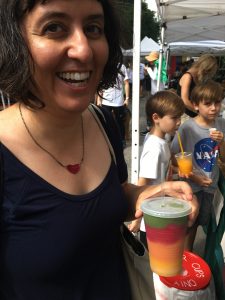This semester my aesthetics class visited FIU’s Frost Museum. We were lucky enough to have Emily Afre to show us around. Emily is the Frost museum’s education specialist and I’m so pleased that she took the time out to answer a few questions about her job, the Frost, and the art scene in Miami!

How did you get involved in museum work?
I took a course called Aesthetics & Values in 2017 with the Honors College at FIU. The class involved visiting museums and galleries in Miami, some of which I had never visited before. Our final project was to curate an exhibition of local contemporary artists to be on view at the Patricia & Phillip Frost Art Museum. I worked with artist, Felicia Chizuko Carlisle who created a sculpture she used in a live experimental sound performance the night of the opening. As a member of the Exhibitions Committee, we worked closely with the artists and installation, and provided tours of the exhibition during the opening. I was interested in becoming more involved and began an internship at the museum, where I currently work full-time.
What art do you recommend in Miami right now (besides exhibits at the Frost)?
Our neighboring museums and galleries always have something to offer year-round. Miami Art Week is Dec 4-9. Aside from Art Basel, there are several satellite fairs, alternative art shows and independent music concerts and live performances.
What do you wish students knew about the Frost that they don’t currently know?
The Patricia & Phillip Frost Art Museum offers free admission to everyone, you don’t just have to be an FIU student. The Frost Art Museum always has programs and events throughout the semester, sometimes featuring artists, scholars, and professionals of all disciplines. Students are also welcomed to experiment with their artistic skills in our MakerSPACE. The Frost Art Museum is also a great place to study!
What do you think the most rewarding part of your job is?
My role at the museum involves a direct relationship with FIU and the community. The most rewarding part of my job is engaging with students of all ages on tours and seeing the larger connections they create.
How does philosophy connect with your work?
Sometimes, we tend to forget that there is a person behind the artwork – the product is the result of one’s psychology and the creative tendencies of the mind. It may be seen as the interpretation of the way an individual understands themselves and the space around them. There are so many questions you can ask when thinking about the nature of art. What and who dictates art as “good” or “bad?” How does art connect to others and how does this change over time? To what extent does the relationship to the human condition deem art successful or effective?
What was your favorite exhibit at the Frost so far?
Hands down, Rafael Soriano: Artist as Mystic. This was a retrospective of Cuban painter, Rafael Soriano. The exhibition spanned works from early geometric abstraction to biomorphic and surrealistic abstractions. His later work following the 1980s, involve themes of psychoanalysis, introspection, the metaphysical, and the unknown. Although he primarily used oil paint, which is heavy and opaque, he is known for achieving extraordinary luminosity in his works. You can find images here.
What projects are you working on right now?
Currently, the Frost is collaborating with The Roar Miami, FIU’s student-run radio station on Art Pop! This event is scheduled to take place Thursday, December 6 from 4:00 p.m. – 7:00 p.m. on the PPFAM Terrace. In efforts to celebrate the end of the semester, Miami Art Week, and The Roar’s 30th Anniversary, we will be conducting giveaways to Art Basel and III Points Music Festival. To enter the giveaways, students must participate in an interactive sculpture inspired by Relational Undercurrents: Contemporary Art of the Caribbean Archipelago, an exhibition currently on view at the Frost. There will also be live performances by local bands and Roar DJs.
What do you wish other people knew about your job (or something people get wrong about your work)?
Well, I don’t just give tours! I spend most of my time researching exhibitions and creating study material for all staff and gallery guides. I also coordinate tours with FIU, as well as school and community groups. I also have been tasked with leading our Gallery Guide Program, an internship open to students of all majors. Collectively, we study current and incoming exhibitions, conduct tours, and plan student programming.
What makes the Frost unique?
Unlike most other museums and galleries in Miami, the Frost is located on a university campus. At times, the Frost is a student’s first experience of an art museum. The museum exhibits work from around the globe, as well as from different time periods.
How do your identities shape your work?
Although I love art history and museum work, my ultimate career goal is to record and perform music as an independent artist. I would say that music is a defining feature of my identity and this has helped shape my work at the Frost. I view the act of giving tours, almost like a performance! This also comes into mind when thinking of programming collaborations and opportunities with university and community initiatives. In addition, I am a recent FIU graduate with a Hispanic background – it is easy to relate to the FIU community! Being a young woman in the arts, it’s rough out here – but the Frost encourages forward-thinking and creativity that goes against any limitations that may have been placed by society.
Thanks Emily!



